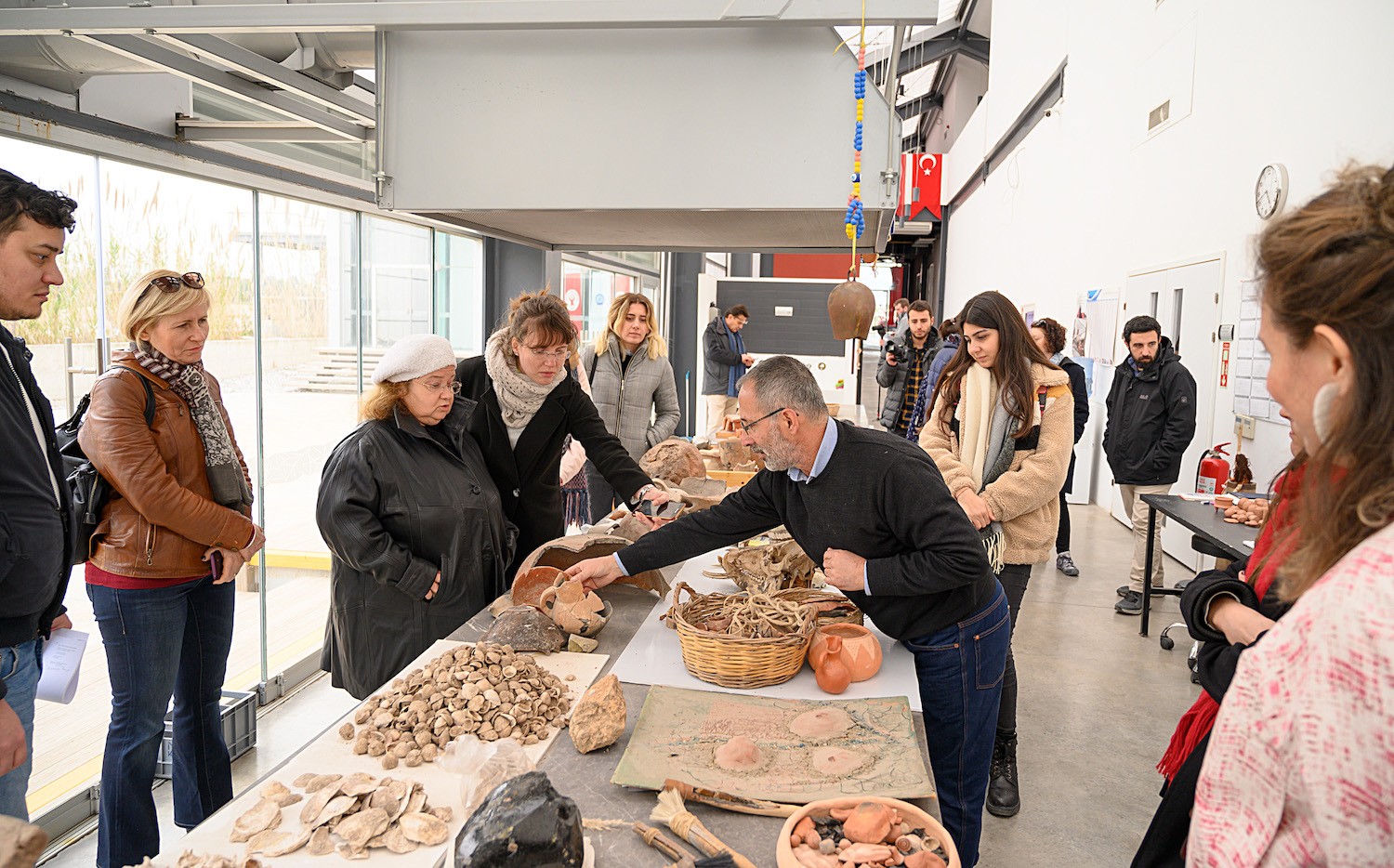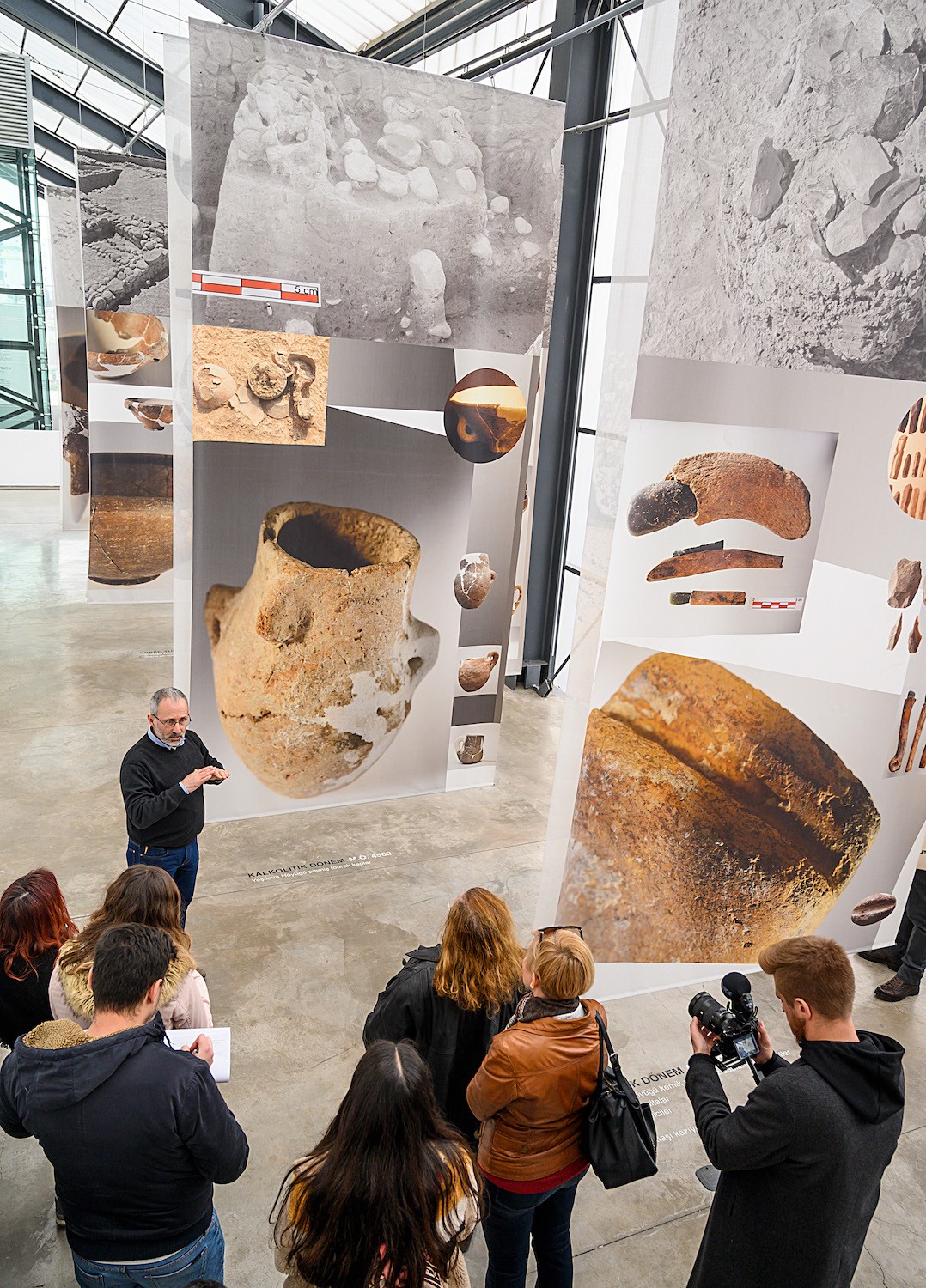Neşe Uzunkaya
* This article has been written by journalist Neşe Uzunkaya, who attended the Archaeological Reporting Workshop for Journalists in İzmir organized by SARAT Project. We publish the article with the permission of the author.
The artefacts discovered in the Neolithic settlement of Yeşilova Höyüğü (Mound) rewind the history of İzmir back 8.500 years, offering visitors a time travel-like experience. The findings from the excavations presided over by Assoc. Prof. Zafer Derin shed light on the oldest populations to have inhabited İzmir.
Yeşilova Höyüğü Visitor Center in the Bornova district of İzmir hosted the Archaeology Reporting Workshop for Journalists organized by SARAT Project (Safeguarding Archaeological Assets of Turkey) with a view to strengthening the bonds between archaeologists and journalists, and eliminating possible errors in news coverage. After the workshop, the chief of excavations, Assoc. Prof. Zafer Derin took the visitors on a tour of Yeşilova Höyüğü, and provided them information.
Yeşilova Höyüğü Chief of Excavations Assoc. Prof. Zafer Derin, SARAT Project Coordinator Dr. Gül Pulhan, SARAT Media Expert Nur Banu Kocaaslan, Archaeologist Dr. Haluk Sağlamtimur, İzmir Agora Chief of Excavations Archaeologist Prof. Akın Ersoy as well as journalists and archaeologists from İzmir attended the event in Yeşilova Höyüğü Visitor Center, which harbours artefacts attesting to the settled lives of the Aegeans who lived in the region 8500 years ago. Following the presentations by archaeologists, Assoc. Prof. Zafer Derin took the participants on a tour of the Yeşilova Höyüğü excavation house and excavation site.
Indicating that the oldest inhabitants of İzmir lived in Yeşilova Höyüğü 8.500 years ago, Assoc. Prof. Zafer Derin said, “The inhabitants seem to be a rather civilized and peaceful population which produced clay pots, ground wheat on stone mortars, and baked bread. The elegance of the terracotta pots suggests that it was women who produced them. We see that they especially favoured the colours red, brown and blue and used these on pots.”

Stating that the stone axes displayed in the visitor centre were used for hunting animals, Derin added “The finds help us understand what their houses looked like. These people weren't very bulky. They were smaller than the humans of our age. From clay, they produced not only food containers but also many other items they needed. We may think that 8,500 years ago people ate with their hands, but in fact they manufactured small clay spoons to feed their babies. We found some of these in our excavation area, and they are now on display.”
Assoc. Prof. Derin indicated that another important find is the fingerprints found on a petrified lump of clay and now in the excavation house: “The fingerprints found on this lump of clay show us that young girls and women worked on processing the clay for making terracotta pots. On the clay lump, we have the fingerprints of a rather diminutive, young individual. These fingerprints are of great importance since they bear the traces of a touch which reaches us through 8,500 years of history. By examining these fingerprints, we can see the actual traces of the people who dwelled here 8,500 years ago.”
Assoc. Prof. Derin indicated that the peaceful and relatively civilized community which inhabited Yeşilova Höyüğü 8,500 years ago disappeared over time, and was replaced around 5,000 years ago by a more belligerent and relatively less civilized community hailing from Europe. This group settled on Yassıtepe Höyüğü, right next to Yeşilova Höyüğü, and was at a lower level of civilization, as indicated by the coarseness of their terracotta objects. Derin added that this community became more civilized over time and started to churn out more advanced clay pots.
Inhabitants of İzmir loved fish back then, too
Assoc. Prof. Zafer Derin stated that they took painstaking efforts to unearth even the slightest trace of the inhabitants of Yeşilova from 8,500 years ago: “Among the finds are plant remains such as grape seeds, wheat and lentils. We see plenty of mussel shells as well. Although the coastline was far away back then, people knew how to extract food out of the sea. İzmir's famous fish, sea bream was part of their menu 8,500 years ago, as attested by the fish bones that we have unearthed. We can say that the inhabitants of İzmir back then ate more or less what the contemporaries eat, including grapes, must and sea bream.”

Assoc. Prof Derin said that the mound had no human bone or skeleton from 8,500 years ago: “We know that in Çatalhöyük the houses are adjacent to each other and that the dead are buried underneath the floors of the houses. Here, however, the houses were not adjacent. Each was built out of clay and mud as separate units, with roofs probably made of reed. We think that the free and independent spirit of the Aegeans date back to those days. In the Yeşilova Höyüğü, the dead are not buried inside the houses. We encountered no human bones or skeletons dating to 8,500 years ago. It could be that people left the dead in nature, to be consumed by wild animals. We are not sure. At the time, wild animals such as leopards and wild boars were widespread in Western Anatolia.”
Assoc. Prof Derin indicated that, at the Visitor Centre created with the contributions of Bornova Municipality, they try to offer an archaeological experience that is immersed within society. He added that large groups need to make an appointment to visit the mound, while groups of 1-2 people can visit whenever they wish to, and all visitors may join a guided tour by an archaeologist to discover the area, free-of-charge.
WHAT IS THE SARAT PROJECT?
SARAT Project is short for ‘Safeguarding Archaeological Assets of Turkey’. The goal of this project is to enhance information, capacity and awareness for safeguarding the archaeological assets of Turkey. To this end, various studies and training programs are implemented.
